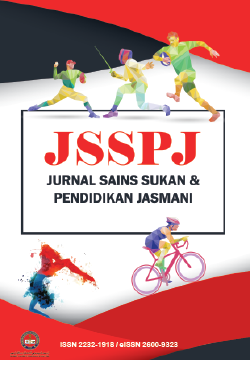Effectiveness of Volleyball Skills Instrument
DOI:
https://doi.org/10.37134/jsspj.vol11.2.3.2022Keywords:
Effectiveness, Volleyball Skills InstrumentAbstract
This study aimed to determine the effectiveness of volleyball skills instrument. The study was conducted on a team from Serambi Mekkah University in Acheh. A total 40 male students aged between 18 -25 years old were involved in this study and has been categorized into two group of expert (n=20) and novice (n=20) athlete. Statistical analysis independent sample T-test was used for data analysis to compared movement and outcome score between expert and novice athlete on serve, dig, set, block, and spike skill. Result of the study found that, expert athlete were significantly (p<0.05) perform higher score than novice athlete in the validity of movement construct for serve (t = 14.091; p = .000), dig (t = 5.044; p = .000), set (t = 12.632; p= .000), block (t = 13.816; p = .000), and spike (t = 16.716; p= .000). The same result also showed in the validity of outcome construct for serve (t = 4.181; p = .000), dig (t = 7.285; p = .000), set (t = 8.219; p= .000), block (t = 10.922; p= .000), and spike (t = 7.922; p= .000). Furthermore, the validity value of instrument‘s battery for volleyball skills movement score was (t = 16.490; p = .000) and the validity value of instrument’s battery for volleyball skills outcome score was (t = 10.792; p= .000). It is concluded that this volleyball skills instrument is effective as a good measuring instruments for the skills of volleyball players between ages of 18 until 25 years old.
Downloads
References
Ahmad Hashim. (2015). Pengujian, Pengukuran dan Penilaian Pendidikan Jasmani. Edisi Pertama. Dubook Press Sdn Bhd.
Campbell, D. T., & Stanley, J. C. (1963). Experimental and quasi-experimental design for research. Hope-well, NJ: Houghton Mifflin Company.
Gabbett, T. J., & Georgieff, B. (2006). The development of a standardized skill assessment for junior volleyball players. International Journal of Sports Physiology and Performance, 1(2), 95-107.
Ghazali & Sufean, (2016). Metodelogi Penyelidikan Dalam Pendidikan. Penertbit. University Of Malaya.
Gogoi, D., & Pant, G. (2017). A comparative study on eye-hand coordination ability between attackers and blockers in volleyball. International Journal of Research and Analytical Reviews, 4(2).
Karalic, T., Ljubojevic, A., Gerdijan, N., & Vukic, Z. (2016). Correlation of specific coordination by young female volleyball players and performance level of technical elements in volleyball. Sportlogia, 12(1), 1–16.
Kumar, S. (2014). Differentials on passing ability between universal attackers and blockers of volleyball players. International Journal of Physical Education, Fitness and Sports, 3(4).
Kyprianou, M. (2015). Evidence for differences in men’s and women’s volleyball games based on skills effectiveness in four consecutive olympic tournaments. Comprehensive Psychology, 4, 30.50.CP.4.9.
Lopes, M. C., Magalhães, R. T., Diniz, L. B. F., Moreira, J. P. A., & Albuquerque, M. R. (2016). The influence of technical skills on decision making of novice volleyball players. Revista Brasileira de Cineantropometria & Desempenho Humano, 18, 362-370.
Othman, Talib. (2013). Asas Penulisan Tesis Penyelidikan & Statistik.. Serdang, Selangor: Universiti Putra Jaya.
Serrano, A. G. de A., David Valades, & Palao, J. M. (2016). Evolution of game’s demands from young to elite players in men’s volleyball, International Journal of Sports Physiology and Performance, Human Kinetics, Inc.
Vansteenkiste, P., Vaeyens, R., Zeuwts, L., Philippaerts, R., & Lenoir, M. (2014). Cue usage in volleyball: A time course comparison of elite, intermediate and novice female players. Biology of Sport, 31(4), 295-302.
Downloads
Published
Issue
Section
License
Copyright (c) 2022 Febi Aulia, Ahmad Hashim, Zulakbal Abd Karim, Saifuddin, Noorzaliza Osman, Sadzali Hassan

This work is licensed under a Creative Commons Attribution-NonCommercial-ShareAlike 4.0 International License.





